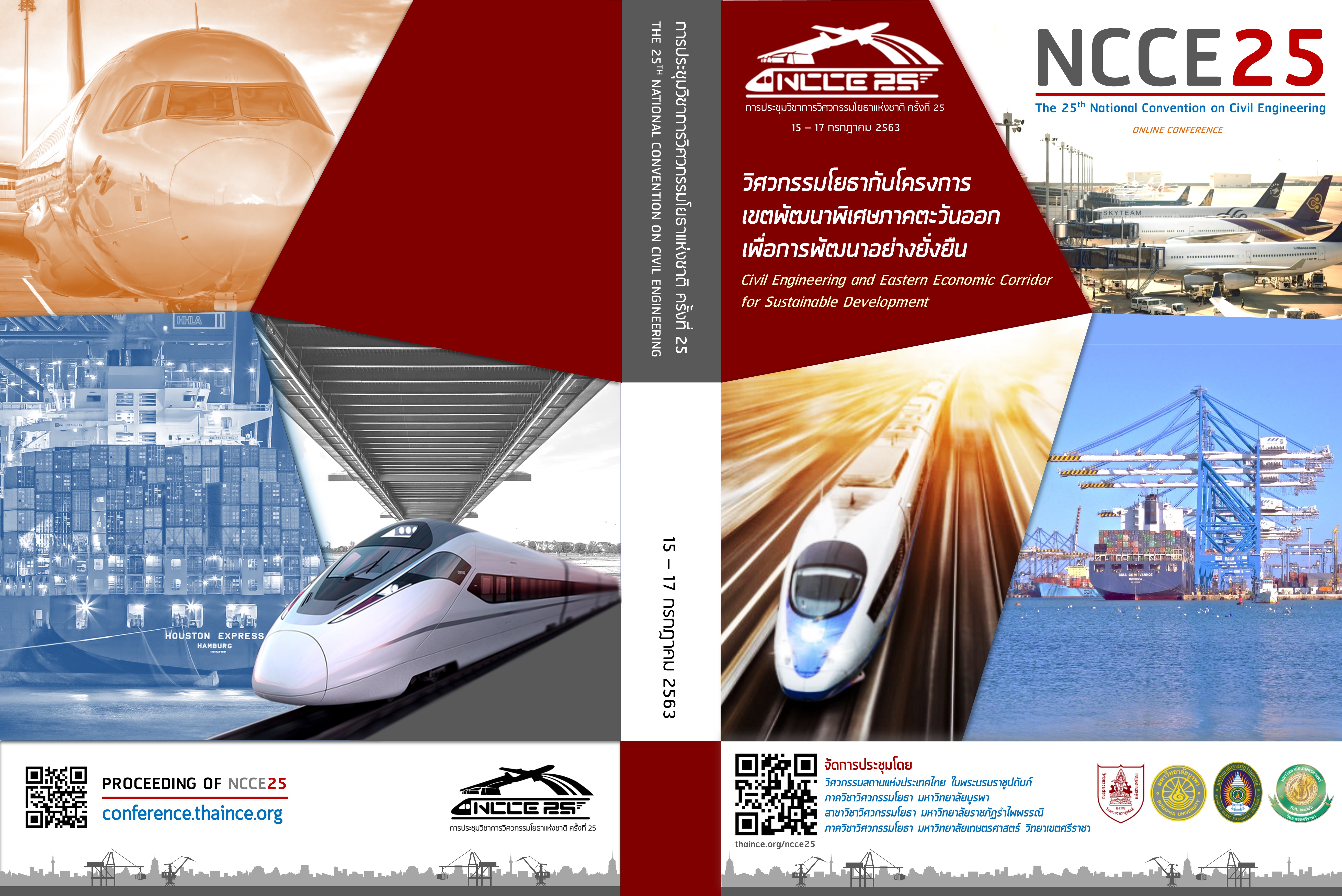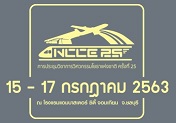Compressive Strength and Water Permeability of Concrete Mixed with Steel Fiber
Keywords:
กำลังอัด, การซึมผ่านน้ำ, คอนกรีต, เส้นใยเหล็กAbstract
This research aims to investigate the compressive strength and water permeability of concrete containing steel fiber (SF). The cement concrete with the water to binder ratios (w/b) of 0.50 and 0.60 were used in this study. The SF was added in concrete at the contents of 0.5% and 1.0% by volume of concrete. The compressive strength and the water permeability of concrete were tested at the ages of 7 and 28 days of water curing. From experimental results, it was found that the utilization of 0.5%of SF content resulted in the highest compressive strength and the lowest water permeability for both concretes with the w/b of 0.50 and 0.60. But, when SF content was increased more than 0.5, the compressive strength decreased and water permeability increased. It was because a large amount of SF may induce the voids between fiber and concrete, leading to higher porosity and water permeability and lower compressive strength.
Downloads
References
[2] Fajardo, G., Valdez, P. and Pacheco, J. (2009). Corrosion of steel rebar embedded in natural pozzolan based mortars exposed to chlorides. Construction and Building Materials, 23, pp. 768–74.
[3] S. Mindess, 1981. Concrete. Prentice-Hall, Inc.
[4] Gizybowski, M. and Shah, S.P. (1990). Shrinkage cracking of fiber reinforced concrete. ACI Materials Journal, 87(2), pp. 138-148.
[5] Padron, I. and Zollo, R.F. (1990). Effect of synthetic fibers on volume stability and cracking of Portland cement concrete and mortar. ACI Materials Journal, 87(4), pp. 327-332.
[6] Sanjuán, M. A. and Moragues, A. (1997). Polypropylene-fibre-reinforced mortar mixes: optimization to control plastic shringkage. Composites Science and Technology, 57, pp. 655-660.
[7] Puertas, F. Amat, T. Fernández-Jiménez, A. and Vázquez, T. (2003). Mechanical and durable behavior of alkaline cement mortars reinforced with polypropylene fibres. Cement and Concrete Research, 33, pp. 2031-2036.
[8] Song, P.S., Hwang, S. and Sheu, B.C. (2005). Strength properties of nylon- and polypropylene-fiber-reinforced concretes. Cement and Concrete Research, 35, pp. 1546-1550.
[9] Antonaci, P. Bocca, P. and Grazzini, A. (2006). In situ determination of toughness indices of fibre reinforced concrete. Materials and Structures, 39, pp. 283-290.
[10] ปรัชญา จูเหล็ง และนัฐภา ภาระศรี (2547). การศึกษาพลังงานการแตกร้าวของคอนกรีตและกำลังรับแรงดัดของคอนกรีตเสริมเหล็กผสมไฟเบอร์. ปริญญานิพนธ์ตามหลักสูตรวิศวกรรมศาสตรบัณฑิต สาขาวิชาวิศวกรรมโยธา มหาวิทยาลัยบูรพา ชลบุรี.
[11] ทวีชัย สำราญวานิช อภินันท์ ภู่ชัน และสุรสิทธิ์ หมั่นวิชา (2550). พฤติกรรมและวิธีการคำนวณกำลังรับแรงดัดของคานคอนกรีตเสริมเหล็กที่ผสมเส้นใย. วารสารวิจัยและพัฒนา มจธ., 30(2) เมษายน-มิถุนายน
[12] ASTM C 39 (2004). Standard Test Method for Compressive Strength of Cylindrical Concrete Specimens.
[13] STM C 617 (2004). Standard Test Method for Capping Cylindrical Concrete Specimens.
[14] BS EN 12390-8 (2009). Testing hardened concrete-Part 8: Depth of penetration of water under pressure.
[15] กิตติศักดิ์ นนทเขตขยัน และภาณุมาศ ดวงสิทธิโชค (2548). คุณสมบัติเชิงกลของคอนกรีตและมอร์ต้าร์ที่ผสมไฟเบอร์. ปริญญานิพนธ์ตามหลักสูตรวิศวกรรมศาสตรบัณฑิต สาขาวิชาวิศวกรรมโยธา มหาวิทยาลัยบูรพา ชลบุรี.
[16] อภินันท์ ภูชัน และสุรสิทธิ์ หมั่นวิชา (2548). พฤติกรรมและการคำนวณกำลังรับแรงดัดของคานคอนกรีตเสริมเหล็กที่ผสมไฟเบอร์. ปริญญานิพนธ์ตามหลักสูตรวิศวกรรมศาสตรบัณฑิต สาขาวิชาวิศวกรรมโยธา มหาวิทยาลัยบูรพา ชลบุรี.
[17] สราวุฒิ อินทรบ และกิติศักดิ์ ใจตรง (2549). การศึกษาพฤติกรรมของพื้นคอนกรีตเสริมเหล็กทางเดียวที่ผสมเส้นใยเหล็ก. ปริญญานิพนธ์ตามหลักสูตรวิศวกรรมศาสตรบัณฑิต สาขาวิชาวิศวกรรมโยธา มหาวิทยาลัยบูรพา ชลบุรี.
Downloads
Published
How to Cite
Issue
Section
License
บทความทั้งหมดที่ได้รับการคัดเลือกให้นำเสนอผลงานในการประชุมวิชาการวิศวกรรมโยธาแห่งชาติ ครั้งที่ 25 นี้ เป็นลิขสิทธิ์ของ วิศวกรรมสถานแห่งประเทศไทย ในพระบรมราชูปถัมภ์



